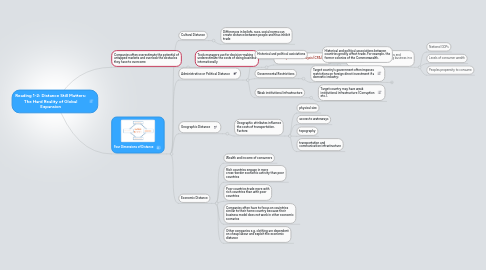
1. Companies often overestimate the potential of untapped markets and overlook the obstacles they have to overcome
1.1. Tools managers use for decision-making underestimate the costs of doing business internationally
1.1.1. Country Portfolio Analysis (CPA)
1.1.1.1. Places emphasis on potential sales and overlooks costs and risks of doing business in a new market
1.1.1.1.1. National GDPs
1.1.1.1.2. Levels of consumer wealth
1.1.1.1.3. Peoples propensity to consume
2. Four Dimensions of Distance
2.1. Cultural Distance
2.1.1. Differences in beliefs, race, social norms can create distance between people and thus inhibit trade
2.2. Administrative or Political Distance
2.2.1. Historical and political assiciations
2.2.1.1. Historical and political associations between countries greatly affect trade. For example, the former colonies of the Commonwealth.
2.2.2. Governmental Restrictions
2.2.2.1. Target country's government often imposes restrictions on foreign direct investment if a domestic industry:
2.2.2.1.1. Is a large employer
2.2.2.1.2. Is seen as a national champion
2.2.2.1.3. Is vital to national security
2.2.2.1.4. Produces Staples
2.2.2.1.5. Produces an "entitlement" good or service
2.2.2.1.6. Exploits natural resources
2.2.2.1.7. Involves high sunk-cost commitments
2.2.3. Weak institutional infrastructure
2.2.3.1. Target country may have weak institutional infrastructure (Corruption etc.).
2.3. Geographic Distance
2.3.1. Geographic attributes influence the costs of transportation. Factors:
2.3.1.1. physical size
2.3.1.2. access to waterways
2.3.1.3. topography
2.3.1.4. transportation and communication infrastructure
2.4. Economic Distance
2.4.1. Wealth and income of consumers
2.4.2. Rich countries engage in more cross-border economic activity than poor countries
2.4.3. Poor countries trade more with rich countries than with poor countries
2.4.4. Companies often have to focus on couintries similar to their home country because their business model does not work in other economic scenarios
2.4.5. Other companies e.g. clothing are dependent on cheap labour and exploit the economic distance

